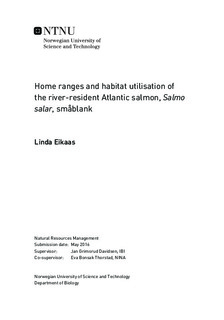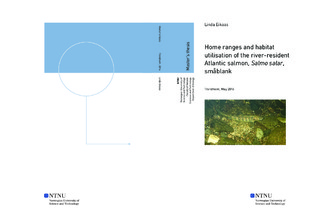| dc.description.abstract | Home ranges and habitat utilisation of the river resident Atlantic salmon, småblank, Salmo salar, in Nord Trøndelag, Norway, were studied by the use of radio telemetry during the period August 2014 to January 2016. The aim was to examine home ranges and habitat utilisation of the fish in the regulated River Namsen in the area of Snåsamoen and in the non-regulated tributary Mellingselva. Furthermore, comparisons in space use between day and night time and between rivers and seasons between the regulated river were investigated. A total of 90 småblank were tagged in three separate periods (Snåsamoen: autumn 2014 n = 33 and spring 2015 n = 20, Mellingselva: autumn 2015 n = 36). Of the total number of radio tagged småblank were 35 individuals randomly selected for radio tracking over a period of 4 to 5 months. The selected individuals were then used for home range analysis (Snåsamoen: autumn n = 15, Snåsamoen: spring n = 6, Mellingselva: autumn n = 16). Home ranges were significantly larger in the regulated river in both seasons, compared to the non-regulated tributary (Snåsamoen: autumn mean = 21 715 m2 and spring mean = 29 688 m2, Mellingselva: autumn mean = 2 362 m2). The condition factor of fish tagged at Snåsamoen was significantly lower than of those tagged in Mellingselva, despite similar body length. The fish with same body length did in addition have significantly larger home range at Snåsamoen than Mellingselva, which can result in småblank having to utilise larger areas to obtain their body condition. The body conditions in spring were significantly lower than in autumn at Snåsamoen, which may be caused by a reduction in body mass during winter. The length of river stretch used was longer when considering only day time locations (Snåsamoen: autumn mean = 301 m and spring mean = 191 m, Mellingselva: autumn mean = 116 m) than when considering only night time locations between rivers and between seasons (Snåsamoen: autumn mean = 104 m and spring mean = 136 m, Mellingselva: autumn mean = 91 m). The fish utilised areas with larger particle sizes in Mellingselva than at Snåsamoen, resulting in more shelter availability. Mellingselva had in general faster flowing water velocities which is often more preferred to Atlantic salmon than slower velocities found at Snåsamoen.
In conclusion, the area investigated in the non-regulated tributary seemed better suited for 3 and 4 years old småblank, than the regulated River Namsen at Snåsamoen. This is based on the results from home ranges, body condition of småblank and habitat availability in the two rivers. | |

